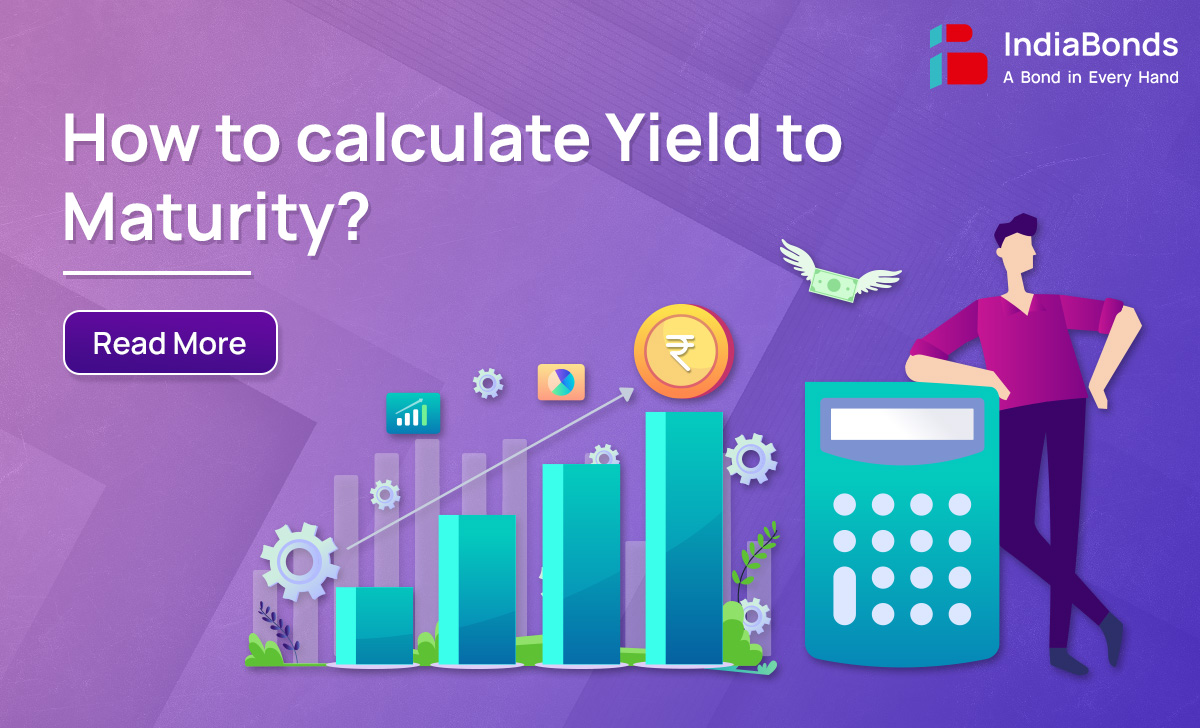How to Calculate Yield to Maturity?

Introduction
Investing in fixed-income instruments is a great way to secure a passive income while reducing portfolio risk. Bonds are one of the best examples when it comes to investing in fixed-income securities. The interest that bonds pay to the bondholder is often represented as the coupon rate. For instance, if a corporate bond has a coupon rate of 10%, that means the bond will pay us interest coupon payments of @10% per annum. But is it always the actual interest that we earn?
Not every time! That’s why you calculate yield to know your actual returns. If you want to calculate returns from a bond, IndiaBonds’ Bond Calculator is a convenient way to calculate your actual returns. The new age yield-to-maturity calculator (YTM calculator) is easy to use and freely available on sign-up. Calculate the exact yield for any bond in a matter of minutes. The YTM calculator helps provide investors with an estimate of the bond’s value thereby helping them make prudent investment decisions.
This article aims to decode yield-to-maturity, how to calculate YTM through a statistical formula, and what causes YTM to increase or decrease.
Yield to Maturity: All that We Need to Know to Interpret It
Yield to maturity is often seen as the internal rate of return (IRR) for a bond, reflecting the total returns expected if the bond is held until its maturity date. This includes all interest payments and the redemption of the principal, with the assumption that all payments are reinvested at the same rate. Understanding the yield to maturity meaning helps investors assess whether a bond’s current trading price offers good value compared to its expected returns, especially when the YTM is significantly higher than the bond’s current interest rate.
What is the Current Yield?
Current yield is the rate at which an investment generates income. It is represented in percentage. All dividends and interest earned on an investment over its lifetime are factored in.
However, it is important to remember that total return and yield are not the same. Since yield considers all cash flows generated by an investment, it is the most comprehensive measure of return.
Calculating the current yield is simple.
The current yield of the bond = (annual interest of the bond / current market value of the bond) * 100




What is Yield to Maturity (YTM)?
The Yield to Maturity (YTM) of a bond is the total amount of returns generated by a bond. It’s the total returns that a bondholder can expect if the bond is held till maturity. Thus, YTM is the total expected rate of return from a bond held till maturity. But how is bond yield calculated?
Here’s the simple formula on how to calculate YTM:
Yield to Maturity = [Annual Interest + {(FV-Price)/Maturity}] / [(FV+Price)/2]
In the formula above,
Annual Interest = Annual interest payout provided by the bond
FV = Bond’s Face value
Price = Bond’s current market price
Maturity = no. of years until the bond matures
Current Yield and Yield to Maturity Calculation: How to Do It?
While the formula for calculating yield to maturity might seem tricky, it actually makes sense. Understanding how Yield to Maturity (YTM) is calculated gives us an insight into how it affects the returns of the bonds we choose. YTM serves as a predictor of possible returns from a bond. Let’s understand how to calculate yield to maturity as well as current yield with a simple example:
Suppose the current market price of the bond is Rs. 900. The face value of the bond is Rs. 1000. This is the price at which the bond will be redeemed. Now, let us assume that the periodicity of the payment is once a year and the bond will mature in 5 years. Also, the bond pays an annual interest at the coupon rate of 8%. Therefore, the annual interest payout is Rs. 80 [Rs. 1000 * 8%]. In this case, the current yield as well as the yield to maturity will be calculated as follows:
Current Yield = (annual interest of the bond / current market value of the bond) * 100
= (Rs. 80 / Rs. 900) * 100
= 8.88% per annum
Now,
Ytm = [Annual Interest + {(FV-Price)/Maturity}] / [(FV+Price)/2]
Ytm = [Rs. 80 + {(Rs. 1000-900) / 5}] / [(1000+900)/2]
= 10.52% per annum
Here’s how to calculate the bond yield, the current yield and yield to maturity for a bond.
Variations of YTM
Yield to Maturity (YTM) is not the only yield calculation investors should be familiar with. The broader landscape of bond yields includes variations like Yield to Call (YTC), Yield to Put (YTP) and Yield to Worst (YTW), each providing unique insights depending on bond features and market conditions.
Yield to Call (YTC)
Yield to Call is especially pertinent for bonds equipped with a callable option, which permits the issuer to repurchase the bond prior to its maturity at a specified price. Unlike Yield to Maturity (YTM), which anticipates holding the bond until maturity, the calculation for Yield to Call assumes the bond will be redeemed at the earliest possible call date. It provides a ceiling on potential returns, as calling typically favors the issuer during periods of declining interest rates. Calculating YTC helps investors assess the risk that their bond investment might yield lower returns than expected if called early.
Yield to Put (YTP)
On the other hand, Yield to Put pertains to puttable bonds, which provide bondholders with the option, though not the requirement, to sell the bond back to the issuer at a predetermined price prior to maturity. This feature is protective for investors, allowing them to exit the investment if the market turns unfavorable or if they need liquidity. This yield calculation helps investors understand the minimum return they can secure, independent of market volatility.
Yield to Worst (YTW)
Yield to Worst is the most conservative of these yield measurements. It calculates the lowest possible yield an investor might earn on a bond without the issuer defaulting. YTW is essential for evaluating bonds with multiple options like calls, puts, or varying coupon rates. It considers the worst-case scenario among all possible outcomes, including YTM, YTC and YTP and assumes the bond will be redeemed or sold at the point that provides the lowest yield.
Critical Role of Yield to Maturity
We should learn how to compare the expected yields from bonds. The returns do not include the interest that we are paid but also the difference between the purchase price and the redemption value of the bond. It’s a must-have for picking out the best investments for our portfolios. Because yields rise when security prices fall and vice-versa, we can use the YTM formula to anticipate how market fluctuations might affect our portfolios. We can check the YTM of a bond and decide whether to add it to our portfolio.
What Are Limitations of YTM?
Although useful, YTM calculations come with limitations, mainly due to the assumption that all coupon payments will be reinvested at the YTM rate. This assumption may not hold true in volatile financial environments, potentially skewing expected returns.
Conclusion
The Yield-to-Maturity (YTM) of a bond helps in more ways than one. Besides allowing us to size up the return prospects of our investments, it also measures the credit risk and liquidity risk of the debt fund. To make a smart investment decision, we must know whether a bond is a good fit for us. A firm grasp of YTM can help with that. Understanding the Average Maturity, Macaulay Duration, and Modified Duration is also important. In addition to YTM, these factors help us get a full picture of the risks associated with our bond investments.
FAQs
Q. Does YTM correspond to the yield on the bond?
A. In a technical sense, absolutely. If we keep our bond until maturity and reinvest the proceeds at the same rate as the YTM, our yield will be the same as the YTM.
Q. What is the definition of a yield curve?
A. The yield curve is a graph generated for YTM against time. It graphically represents how YTM has changed over time. A rising yield curve indicates that long-term yields are higher than short-term yields.
Q. What is the yield to maturity ratio?
A. The yield to maturity (YTM) is a financial indicator that shows the complete return anticipated from a bond if it is kept until the due date. This assumes that all scheduled payments are received and reinvested at the same rate. It incorporates the coupon rate, market price, face value and time to maturity into a single annual rate that reflects the overall yield an investor will receive.
Q. What is yield to maturity formula in Excel?
A. In Excel, the YTM can be calculated using the built-in YIELD function. The syntax is YIELD(settlement, maturity, rate, pr, redemption, frequency, [basis])
Q. How is bond yield calculated?
A. Bond yield can refer to various measures, but generally, it is calculated using the formula for either current yield or yield to maturity. The current yield is simpler, calculated as the annual interest payment divided by the current bond price:
Current Yield = (annual interest of the bond / current market value of the bond) * 100
Q. What is the formula for PMT in YTM?
A. In the context of bonds, PMT typically refers to the payment made per period in financial calculations, which in bonds is the coupon payment. It is not directly a part of the YTM calculation, but it is used to calculate the cash flows from the bond. The formula for the coupon payment is:
PMT = Face Value × (Coupon Rate/ Frequency of Payment)
This PMT value is essential when using financial functions to calculate YTM or constructing cash flow tables for bond investments.
Disclaimer: Investments in debt securities/ municipal debt securities/ securitised debt instruments are subject to risks including delay and/ or default in payment. Read all the offer related documents carefully.













































